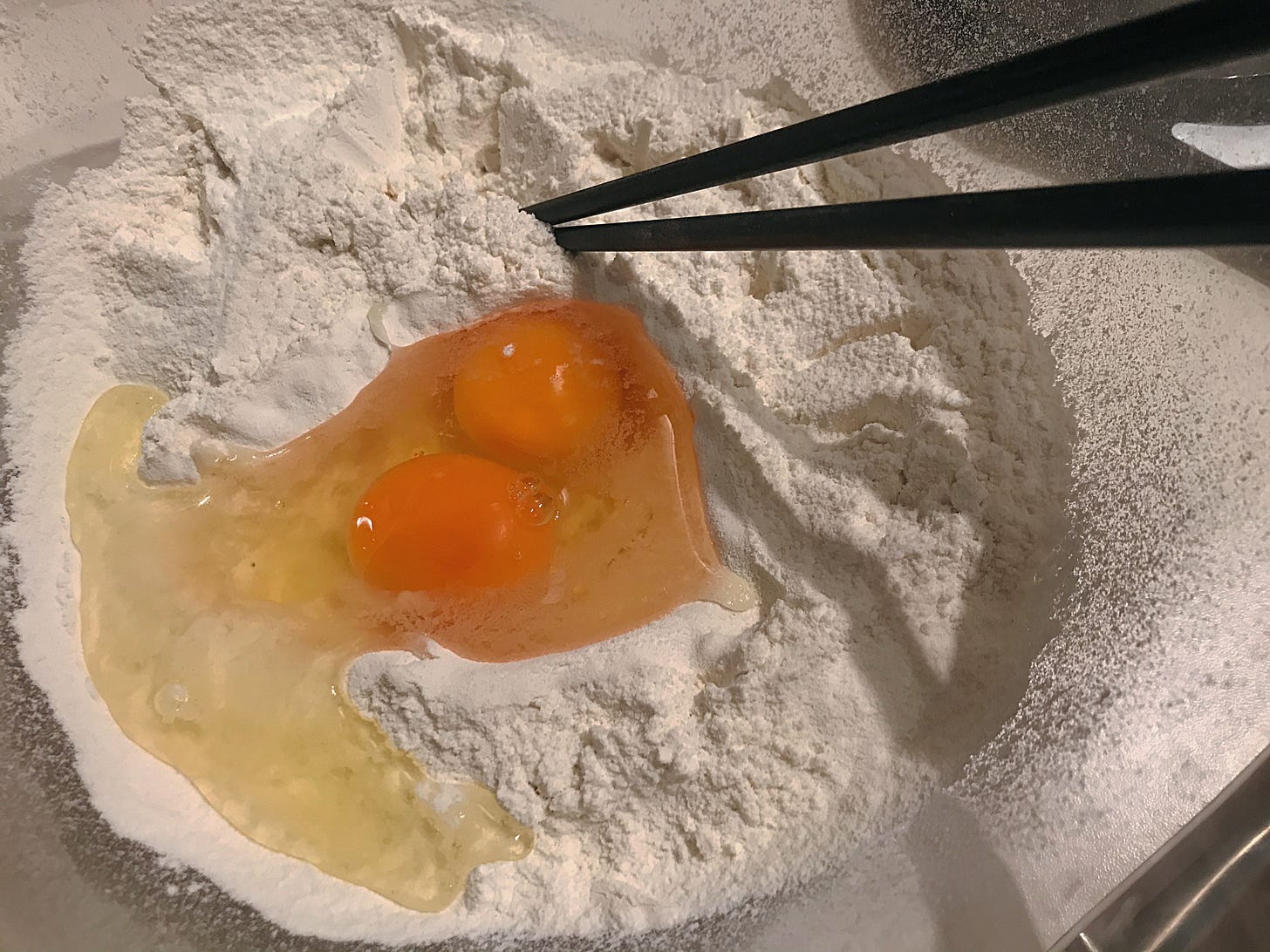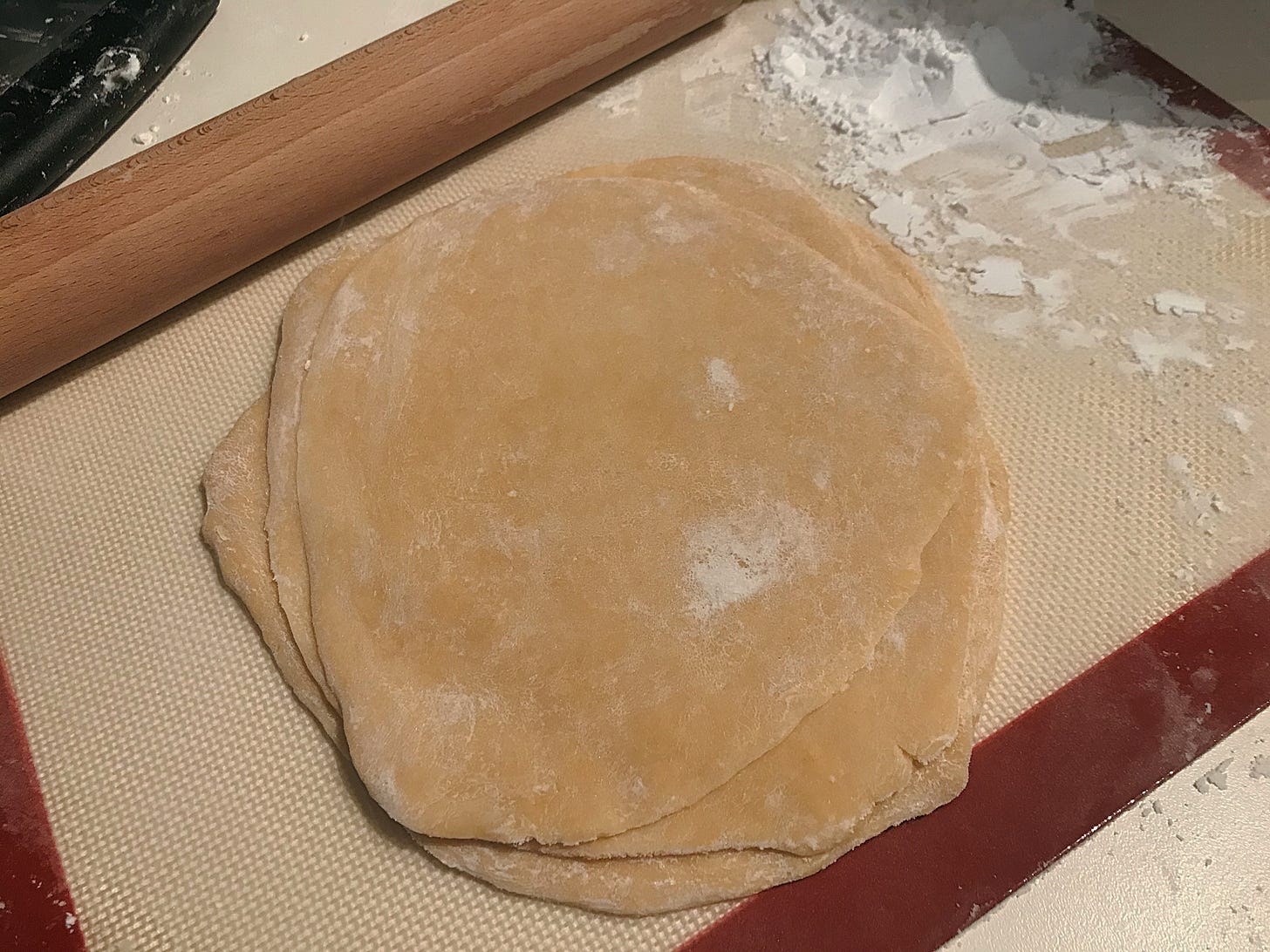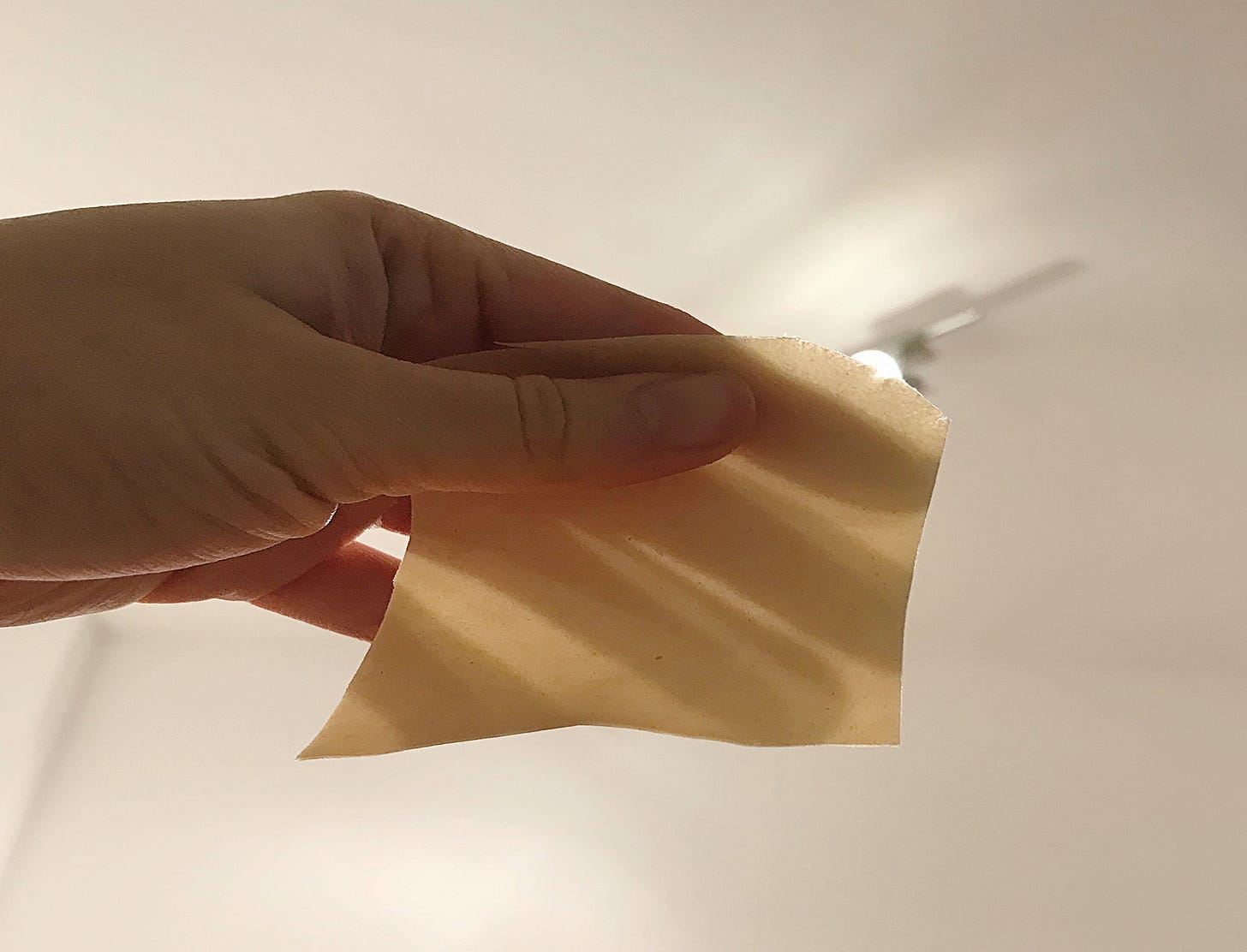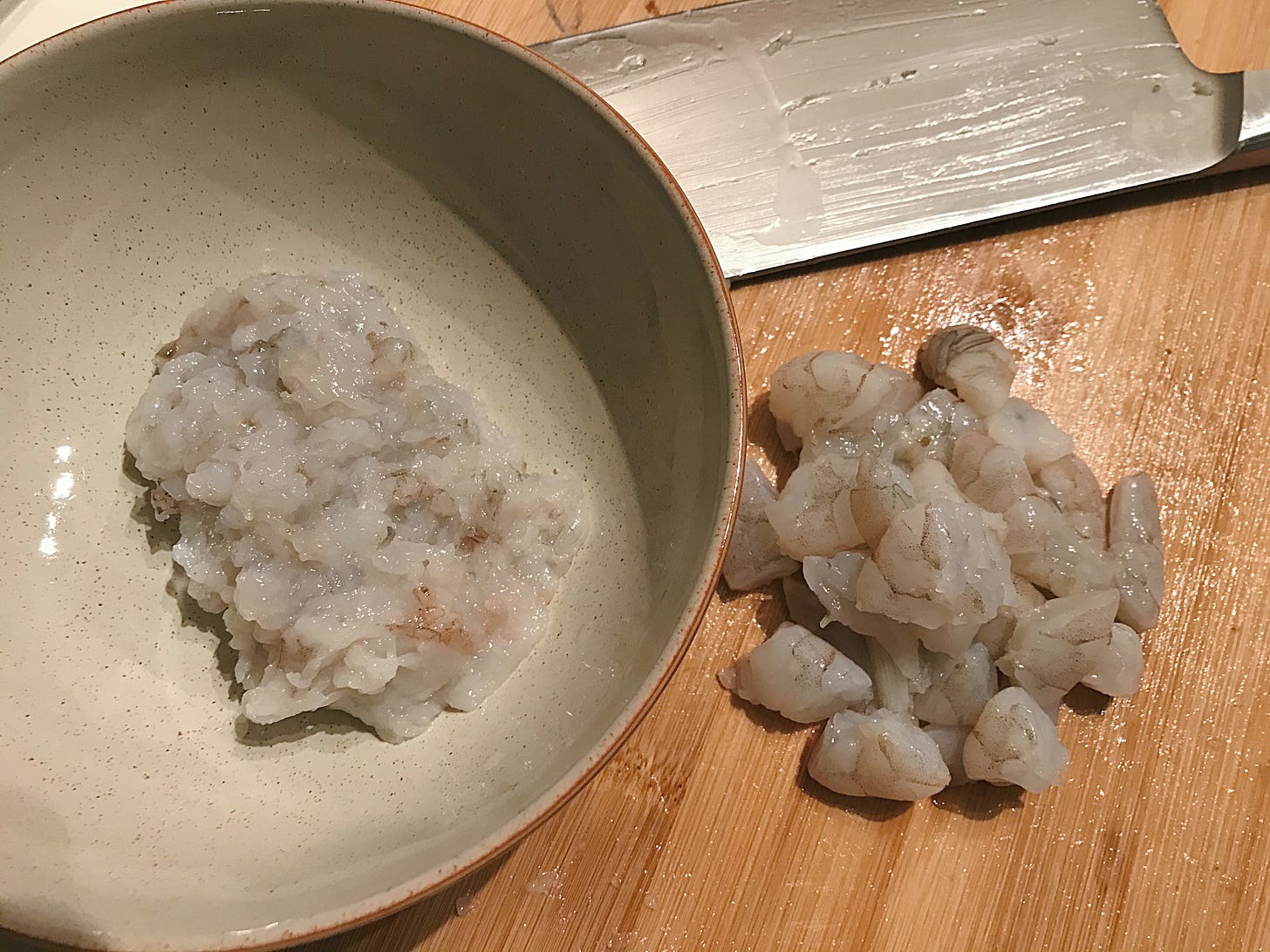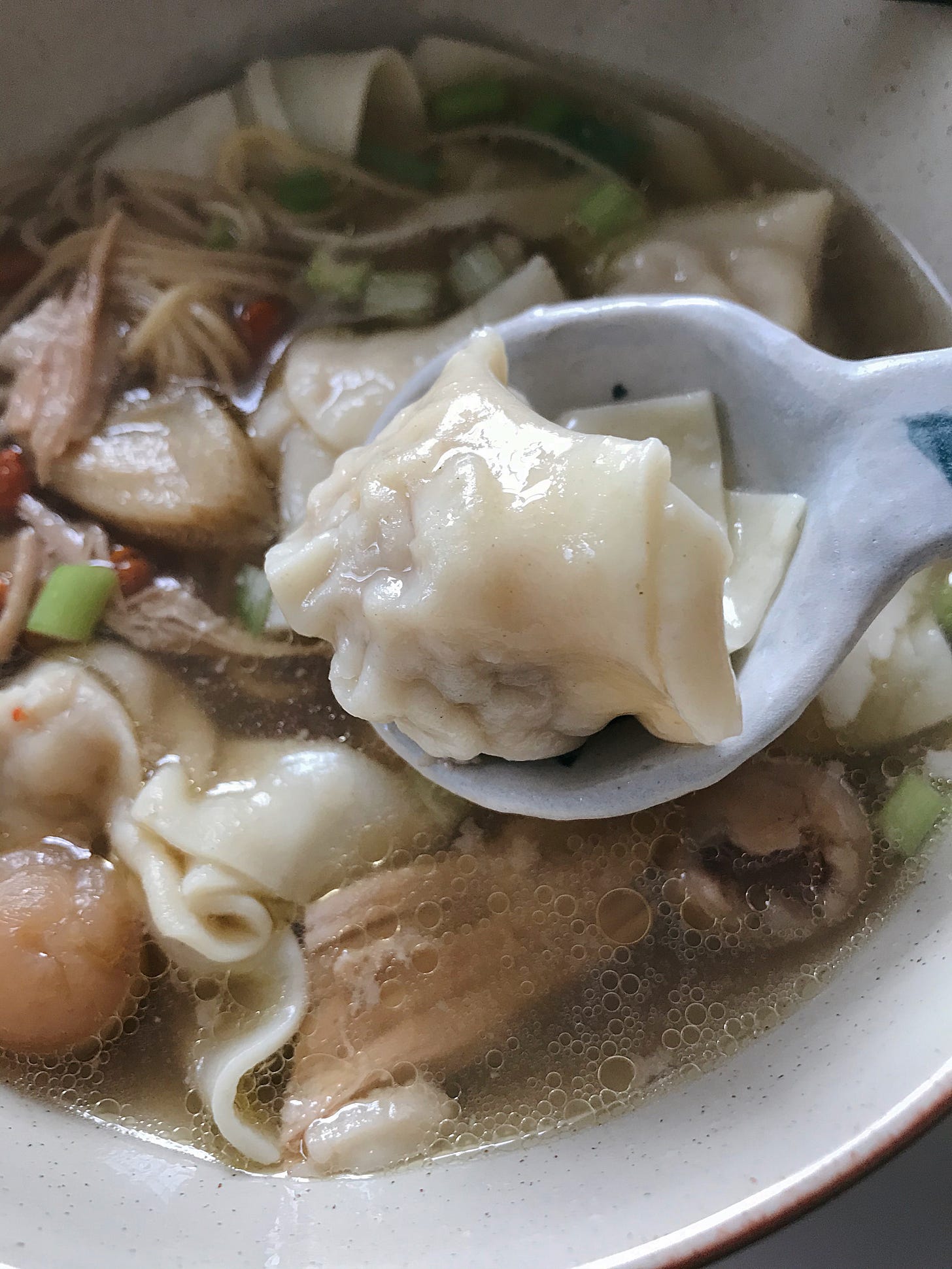Prawn and Pork Wonton Soup
I felt homesick and attempted a classic Cantonese dish.
Growing up in Canton, wontons are a common little thing that can be eaten three times a day. Uncomplicated and consistently comforting, you can find them along every street. Little shops with one or two payment counters right next to the entrance, you order and pay as you walk in, and wait for your number to be called.
As you wait, you see the kitchen equipped with rows of square noodle cookers, each one on a persistent rolling boil, the chefs throwing in and fishing out individual portions of noodles, wontons, and lettuce leaves. You can almost feel the steam of the noodle water travelling around the room, along with the unmissable smell of cooked green lettuce. Next to the kitchen would be the serving counter, where the bowls are filled before a hand sprikles chopped spring onions for garnishing. Then a giant ladle of hot broth is poured in, completing the ritual.
There would be one type of wontons that always sits on the top of most menus - prawn and pork. It is the quintessential filling in Canton and Hong Kong; if you just say ‘wonton’ there that’s what people assume it will contain.
Unless you have dietary requirements, it is really the filling that delivers ultimate comfort. Pork is quite often the preferred meat in many Chinese dishes because it doesn’t taste as strong as some of the other meats, and has the right amount of fat content for texture and flavour. The pork mince provides a perfect meaty but not overpowering base for the prawn, which is lighter in flavour, but has a tender and crisp texture (爽口弹牙).
(In my mind, wonton is also the type of comfort food that I don’t want to bother deciding about specifics of flavour, so I always get the classic.)
Then it’s a choice between with noodles or without (double amount of wontons) depending on how luxurious you feel that day.
Since moving to London post graduation a couple years back, every time I visit my mother, whether it is for a long weekend or for a couple of weeks, a bowl of hot wonton soup always appears the morning before my departure.
It would be without noodles, served with lettuce and hot soup. My little brother would still be lying in, and mother preparing other things in the background, so I would sit there alone, eating my wontons. So delicious that I struggle between the eagerness of getting them in my belly and savouring each bite slowly.
I once asked her ‘When did you make them?’
To which she replied casually, ‘Oh, just a couple days back.’
I always thought that she just makes wontons at her leisure, just like how I enjoy baking that I would always have some bread or cake made and stored away in the freezer.
Until Christmas last year, when I video called with my mum and little brother. I said I missed mum’s wontons, and asked my little brother if he has had any recently. He answered, ‘Oh no, she only makes then for special occasions,’ he paused, ‘and when you come visit’.
I thought about that bowl of clear broth, lettuce sitting at the bottom, twelve little wontons floating on top, steam rising gently from the soup.
Cold winter nights makes it easier to miss home. So one evening around 8:30pm, I decided to make wontons. Typically, unlike dumplings, no one bothers to make wonton skins by hand at home, because they need to be much thinner than dumpling skins and requires more effort. Asian supermarkets were closed, so for the first time, I made prawn and pork wontons completely from scratch. They turned out to be pretty good (otherwise I won’t be sharing).
So here is the recipe for wontons, including wonton skins, the classic prawn and pork filling, and some notes on the soup.
(I don’t specify numbers or servings, because it depends how big you make your wontons, but it should easily feed around 4-5 people.)
Wonton Skin
There are three main things that differentiates wontons from dumplings for me: shape, size, and the wrapping skins. Compared to Chinese dumpling skins, wonton skins are generally thinner, more slippery, and have more bite. (On the other hand, Korean mandus and Japanese gyozas tend to also have thin skins.) Wonton skins are also square in shape before assembly.
I was unsure what exactly made all of this difference, but when I started reading up on making wonton skins it struck me how far away they are from dumpling skins, and how that it is essentially a pasta dough, except for two small differences: 1) you use corn starch for dusting, and 2) sodium carbonate is added to alter the texture of the dough by speeding up gluten development (it also gives wontons that extra yellow colour). As this was a late night craving, I did not have the latter (nor the patience to bake baking soda to get sodium carbonate). However, the texture of the final dough turned out to be pretty close to what I wanted to achieve.
You only need 3 ingredients: eggs, all-purpose flour, and pinch salt. Mix them well, and knead into a ball, then you can cover and rest until ready to assemble, during which you can prepare your filling. Some sprinkles of water might be required to make sure dough comes together.
The dough should feel firm - it’s a relatively dry dough because they will need to survive boiling in water.
After resting for more than 30 minutes (keep in the fridge for longer if you are making ahead), you are ready to roll the dough out into sheets. I have quite a small worktop, so I divided my dough into 4 portions and rolled each one out one by one. A pasta maker would work great if you have one.
Since it is a dry dough rolling is hard work. A tip here if you are rolling by hand is once you have each sheet in a good size (around the size of a paperback book), you can stack them and roll multiple sheets at the same time. Be sure to roll out the edges individually in the end. And dust each sheet generously as you go.
Then you can cut them into squares. I will talk about sizing later, but for now you just want them to be approximately square. Wonton wrapping is quite forgiving, so they can also be a little rectangular, or even triangular if they came from the edges of the dough sheets. I used a pair of scissors as I found it to be easier, but using a knife or a pizza cutter should give you neater edges.
Make sure you dust each final skin before stacking, and cover the skins until assembly. The final wonton skin should be semi transparent.
The key to successful wonton skin is to be patient and roll it out thinly, but not so thin that you might tear in during assembly. The steps are simple but can be time consuming.
Ingredients:
2 medium eggs
220g plain flour
pinch salt
some water to ensure dough forms
corn starch/potato starch for dusting and rolling, and tossing the wontons in if not cooking immediately
Steps:
Sieve flour in large bowl, make well in the middle
Crack in eggs
Using a pair of chopsticks, or a fork, mix the dough roughly
Knead into a ball, cover and rest for ~30 minutes (during which you can make the filling)
Cut the dough into smaller size balls (I recommend 3-4) if rolling by hand, you can also use a pasta roller for steps 5-7.
Use rolling pin to roll out each ball into sheets in turn (so that you give the dough some rest as you roll them out).
Once you have relatively thin sheets, to make them thinner, you can stack the sheets, and roll them out together. Be careful to make them even in thickness.
Use a knife or a pair of scissors, cut out approximate squares of desired size. I recommend 5-8cm width depending on how big you want your wontons to be.
Cover until ready to use.
Prawn and Pork Filling
This is also my first time trying to recreate the correct texture and flavour, and I can assure you that it is a lot of work. (Previous attempts consisted simple pork mince and prawn mince mixed together, much easier.) However, personally, it was worth it.
The first thing is that making the prawn paste is non-trivial, and then both the prawns and pork will need to be marinated separately for 20-30 minutes.
For the prawn paste, you will need raw prawns, deveined. Separate them into two-halves, chop and mince one half with the non-sharp edge of your knife, and cut each prawn into 3-4 pieces for the other half.
Then mix the halves back together, and marinate as described in the recipe below.
After 30 mintutes, mix the prawns and pork mince together, and beat using chopsticks in a circular motion until the mixture forms a paste. This essentially happens once you have mixed the pork mince with the water content from both marinades sufficiently.
I decided to make the filling that contains chopped lard residue 猪油渣 (the remaining crispy bits when you fry pork fat to get lard) and this is the point that it gets mixed in. It is a massive hassle but in my opinion it really elevates flavour and texture of these wontons to a different level. At home there are some restaurants that add them and some that don’t, if you make them without it is the more humble version that is equally comforting. So if you don’t have it at hand feel free to skip this step. Or sub with chopped fried chicken skin.
Ingredients:
250g raw prawns
prawn marinade: 1 tsp sesame oil, 1/2 tsp salt, 1/2 tsp ground black pepper
125g pork mince (ideally 20% fat, but 5% also fine)
pork marinade: 1 tsp corn starch, 1 tsp Shaoxing wine, 1/2 tsp soy sauce, 1/2 tsp granulated sugar, 1/2 tsp ground black pepper
1 egg, beaten
handful of fried lard residue or fried chicken skin, chopped (optional)
Steps:
Separate prawns into two equal portions, chop one portion into paste-form, and the other portion cut each prawn into three chunks. Mix back the prawns.
Add prawn marinade ingredients to prawns, and half the beaten egg. Mix well and rest for at least 20 minutes. Save the other half of egg for assembly.
Add pork marinade ingredients to pork mince, mix well and rest for at least 30 minutes.
While you wait you can roll and cut out wonton skins.
After resting, mix together pork mince and prawn paste. Beat texture firmly in circular motion, until all the liquid is absorbed into the mixture, forming a uniform paste (don’t worry about the chunks of prawns).
Add chopped lard residue, and incorporate into texture.
Cover until ready to assemble.
The Soup
There are several popular recipes for the soup that you eat wontons with. The most traditional Cantonese version calls for clear chicken broth with dried flounder fish, and other common soups include seaweed eggdrop soup, or just the soup you get from cooking the wontons and lettuce. Sea kelp and pork bone broth would also work, but I would not recommend soups with a strong distinct flavour, so no miso, no Gochujang, no ramen broth.
The soup is really there to elevate the umami flavour of the wontons, not to overpower it. The safest option would be a simple chicken soup (one or two chicken legs/thighs, slices of ginger, a few stems of spring onion, boil until chicken is cooked, skim off the frothy bits on top), or seaweed eggdrop soup (soak dried Chinese seaweed, boil with a few slices of ginger until seaweed is cooked, crack in one egg and break and stir the egg vigorously as it cooks).
Assembly
Wontons tend to be smaller than dumplings. Wonton in Cantones is 云吞, the first character meaning ‘cloud’, the second meaning ‘bite (swallow)’. It is said that this came from how the wontons float like little clouds in soup, and you can eat each one with one mouthful (one bite). A good measure for size is around half the size of your standard dumplings.
Common restaurant wontons also have a long tail of skins, and a small bite of filling, but I like to be generous with mine. As a guideline, squares of 5cm for the skins are a good size, but feel free to adapt to personal preferences.
Shaping
There are many ways to shape wontons, but I have only tried two. The reason being the Cantonese method is the simplest but hardest to master, so I opted for an alternate method so I will actually end up with some decent food to eat in the end instead of a pile exploding wonton skins.
The Cantonese method of shaping is simply putting the filling in the centre, and then pinch your purlicue (the space between your thumb and index finger) to squash and seal the skin. The final shape is also known as “goldfish tail” and you can see why from the photo below.
The other method I tried is commonly known as the ‘lotus’ method. It involves folding the skin diagonally or semi-diagonally, sealing the filling inside, and then pinching the two corners together.
With both methods, you really want to seal the fillings securely by pressing the skin firmly together. To help the two sides of wonton skin stick, you could use the remainder of the beaten egg from making the filling as ‘glue’.
Assembled wontons can be cooked and eaten immediately, or toss in more corn starch to store in the freezer.
Cooking and Serving
Additional Ingredients:
Soup
Lettuce leaves - washed
Spring onions - 1 or 2 sprigs, finely chopped
Noodles (optional - I recommend Sau-Tao shrimp-egg noodles)
To serve, have your soup boiling in the backround, and have a handful of lettuce leaves and spring onions ready. If you want to have noodles with wontons, cook them now.
To cook the wontons, boil a pot of water (with plenty of depth so they can float up), and add wontons individually. Make sure it is not too crowded, and ensure they do not stick to the pot at the beginning. If your wontons are relatively small, it should be done once they float to the top.
Once you have taken the wontons out, keep the water boiling, add lettuce leaves and cook them for 10-15 seconds.
In a bowl, assemble - cooked lettuce leaves, noodles, then wontons.
Scatter spring onions. Pour hot soup. Serve.
Afterword
Before making this I did not realise how complicated the steps were to make a perfect bowl on wonton soup. Back home they are so easily accessible, and almost everywhere you go you are guaranteed a good meal. Restaurants in London have wonton soup on their menus too, but they don’t really taste the same, and lockdown rules them out because somehow I feel this dish should be eaten fresh out of the pot.
The next morning I invited my neighbour around for breakfast; wonton soup is best eaten shared.
Thank you for reading :)




